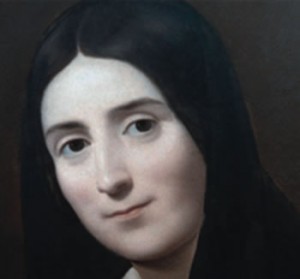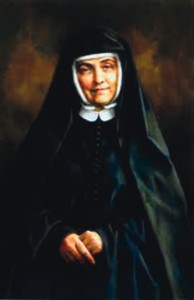Venerable Cornelia Connelly — Wife, Mother, Foundress
Many people today may not have heard of Cornelia Connelly, but this was not so in the middle of the 19th century. The drama-filled life of the Foundress of the Society of the Holy Child Jesus made news in Britain and the United States and she became a household name, though not always for the right reasons.
Cornelia Peacock was born into an Episcopalian family on 15 January 1809, in Philadelphia. When she was fourteen her mother died and having lost her father five years before, she went to live with an older sister, while her siblings were taken in by other family members.
Seven years later in December 1831, she married Pierce Connolly, an Episcopalian minister, and the couple moved to Mississippi. The following year their son Mercer was born; by the time their second child arrived in 1835, Pierce had decided to convert to Catholicism. However, not a man to do things by half, he decided to study the Church at its source - Rome. Cornelia, however, converted immediately and arrived in Rome already a Catholic. During the next two years, another son, John Henry, was born, and Pierce was received into the Catholic Church.
Family tragedies and changes in vocation
The family returned to the United States in 1838 and settled in Grand Coteau, Louisiana, where Cornelia taught music and art at the Sacred Heart Convent School. While she loved her work, Pierce was less enthusiastic about his teaching job at St Charles’s College and over time he grew more and more unhappy. Then tragedy struck with the death of a daughter who survived only a few weeks; and almost a year later John Henry suffered horrific burns in an accident and died in his mother’s arms. In her grief Cornelia turned to Our Lady of Sorrows and so became devoted to her for the rest of her life.
Later that same year, 1840, Cornelia was expecting their fifth child when her husband broke the news he felt he was being called to the priesthood. It was not an easy process, as with a young family to support, Church authorities were reluctant to accept him for ordination. No amount of persuasion by Cornelia would change his mind and two years later Pierce travelled to Europe with his young son Mercer, placing him in boarding school in England while he went to Rome to plead his cause.
The Church required Cornelia’s full consent to a marriage separation before it would consider Pierce’s request, so two years later, with two young children in tow, she arrived in Rome. Still unable to change his mind, she signed official documentation for separation and vowed a life of chastity. Cornelia and her children moved into the Trinita dei Monte convent in Rome where she became a postulant. She still wasn’t sure if this was where God wanted her, so began praying in earnest for guidance.
A new religious congregation
Eventually Cornelia received an unexpected answer to her prayers. Bishop Nicholas Wiseman asked her to found a new religious Order and school in England and in 1846 she travelled to Derby with her children. Most English schools at that time were run by the Anglican church and Catholics were not permitted to attend. While there were some Catholic schools for boys (usually from wealthy families), there were none for girls and this was where Cornelia and her new Order would feature.
But even here, things would not go smoothly. The Bishop, having promised her she could keep her children with her, now insisted they go to boarding school and only when she had taken her final vows and established her school, could they return. Little did Cornelia know then that she would never see her children again.
The Society of the Holy Child Jesus began to take shape. Girls from poor families were taken in and taught needlework, music, art and social studies along with the basics of English and maths. Cornelia loved her work and prepared to take her final vows but her husband had other ideas. Pierce had become increasingly discontented with the priesthood and began a campaign to persuade her to leave the Church and return to him. He wrote constantly and once arrived at the convent unannounced demanding to see his wife, then became enraged when she refused to see him.
In early 1848, Pierce left the priesthood and the Catholic Church. He then took the children out of their schools and moved them to Europe, refusing to tell her where they were and denying all contact until she renounced her vows and returned as his wife. Cornelia was devastated but stood her ground, certain she was where God wanted her, and accepted the situation. Although she did eventually locate her children and wrote often, all her letters were returned unopened.
When depriving her of her children didn’t work, Pierce tried another tack, a move that was to have far reaching consequences in the straight-laced society of Victorian Britain. He issued Cornelia with a writ for restitution of his conjugal rights. The case dragged on for two years, during which time she and her congregation were constantly in the limelight. Newspapers - on both sides of the Atlantic - focused on the scandal. This was fuel to the fire at a time when anti-Catholic feelings were running high in England.
In 1850 Pierce won his case with the court ruling that the Catholic Church had no jurisdiction in English law. Although his wife was ordered to return to him, her solicitors immediately appealed the decision which was overturned the following year. Her husband’s finances prevented him from taking further action, so Cornelia was free to continue her work with the Order. Further heartbreak came in 1853 when she was told of the death of her first-born Mercer, who died from yellow fever on his return to the United States.
“I belong all to God”
Once again Cornelia turned to her faith, declaring “I belong all to God”. Her work became her life and in the years that followed schools were established in several other English cities, as well as one in France and another in the United States. In 1863 she wrote a ‘Book of Studies’ outlining her curriculum which focussed on innovative teaching, including the importance of the arts and of outdoor activities.
Controversy courted Cornelia for the remaining 16 years of her life. Pierce continued to vilify her and the ongoing publicity affected the application she made to the Vatican for acceptance of the Rules of her Order. Although she became Mother Superior, Bishop Danell appointed himself Bishop Superior, thus overruling her authority in the Order and establishing his own rules. This also meant the sisters were allowed to take only temporary vows and it was a mere four months before Cornelia died that this restriction was lifted and they were able to take their final vows. Eight years after her death in April 1879, her Rules were accepted by the Vatican.
When Cornelia Connelly followed her husband into the Catholic faith she could never have known the course her life would take and the sacrifices she would have to make. Ultimately she chose to follow God’s will and in doing so, changed the lives of multitudes of young women who would otherwise have received no education. Her teaching was radical: expanding the mind was vital for the girls to have a real chance in life. An 1853 Inspector’s report talked about “this very interesting school” and the “consummate skill in the art of teaching, unwearied patience and the most persuasive personal influence”.
Today her legacy lives on through the Holy Child convents and schools operating in Europe, the United States and Africa. In 1959 recognition of her life and her work came with a proposal for beatification and in 1992 Pope John Paul II declared her Venerable.


 Entries(RSS)
Entries(RSS)